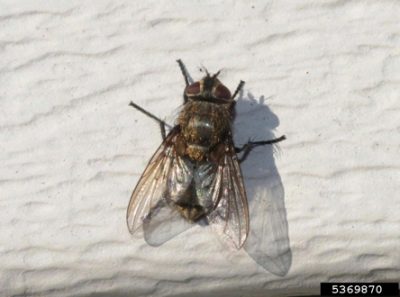Pollenia rudis

Whitney Cranshaw, Colorado State University, Bugwood.orgEvery autumn many buildings are invaded by large numbers of awkward flies that resemble house flies. These insects are commonly called ‘cluster flies' or 'attic flies'. They are clumsy, blundering about lights and windows or colliding with various objects. They often drop to the floor on their backs and spin aimlessly as they futilely try to right themselves.
Cluster flies begin looking for protected areas in the fall as outdoor temperatures drop through the mid 50's. As the days become shorter and the sun drops lower in the southern sky, such temperatures occur more frequently. Flies enter buildings through any available opening. Once inside, they tend to gather and hibernate in secluded areas, such as wall voids or window frames or dark corners of attics. They often rest in clusters numbering in the thousands.
Cluster flies become active again any time the temperature rises to the mid 50's or higher. Such temperatures may be reached as a result of heating from within (furnaces) or on an unusually sunny day. In either case, flies may enter rooms by crawling under baseboards and attic doors, around window sills, through window pulleys or damaged screens, or through electrical fixtures. They are usually found in window sills and other out of the way places, moving sluggishly. In large numbers, they can be a considerable nuisance.
Adult cluster flies resemble house flies, but are larger and much slower in their movements. They are slightly less than ½ inch long, dark gray, with a checkered back and silvery abdomens. The wings overlap over the back when the flies are at rest.
Life Cycle
Adult female flies lay eggs in cracks in the soil in fields, gardens or lawns. Larvae (‘worms' or ‘grubs') hatch in about 3 days and parasitize earthworms in the soil for 11 to 14 days. When the larvae mature, they leave the body of the earthworm and pupate in the ground. Adult flies emerge a few days later. The cycle takes from 27 to 39 days to complete, depending on temperature. Cluster flies complete 2 or more generations each summer. Because the larvae feed on earthworms, rather than on garbage, cluster flies are not as much of a health hazard as are house flies, which sometime carry diseases from place to place.
When cool weather approaches, flies stop laying eggs and begin looking for secluded spots in which to spend the winter. Cluster flies have been observed moving several hundred yards in search of hiding places. Those which survive the winter will return to gardens and fields in the spring to begin a new cycle.
Control
Control of cluster flies usually depends on preventing the flies from entering buildings. Unfortunately, most houses, even the most carefully constructed buildings, provide at least a few places where the flies can enter. Routes by which flies are entering can often be discovered by inspecting and observing the activities of flies on the side of the house where the sun is shining in late afternoon on autumn days. Openings (for example, around window sills or screening) should be sealed with caulking compound or another appropriate sealer.
Similarly, inspect the inside of the building to locate the resting places. Pay particular attention to attics and wall voids. Use a household spray for flying insects. Be careful to remove any dead insects to avoid infestation of other insects (such as larder beetles) that feed on insect remains. All insecticides must be used in strict accordance with directions on the container.
Population levels of cluster flies are directly related to soil conditions in the summer, particularly moisture levels, because such factors determine the survival and availability of the earthworm host. Efforts to control cluster flies by reducing earthworm populations generally are not successful, partly because few pesticides are effective enough against earthworms to reduce populations significantly and partly because adult flies from neighboring, untreated areas can fly considerable distances. Similarly, efforts to control cluster flies themselves with applications of insecticides to lawns and gardens are not effective because the adult flies are never in contact with treated areas long enough to contact sufficient material to be lethal.
Despite good cultural practices, pests and diseases at times may appear. Chemical control should be used only after all other methods have failed. For pesticide information please call UConn Home and Garden Education Center or your local cooperative extension office.
The UConn Home & Garden Education Center supports UConn Extension’s mission by providing answers you can trust with research-based information and resources. For gardening questions, contact us toll-free at (877) 486-6271, visit our website at homegarden.cahnr.uconn.edu, or reach out to your local UConn Extension center at cahnr.uconn.edu/extension/locations.